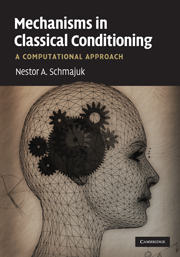Book contents
- Frontmatter
- Contents
- Preface
- Acknowledgments
- Abbreviations
- Part I Introduction
- Part II Attentional and associative mechanisms
- Part III Configural mechanisms
- 11 A configural model of conditioning
- 12 Occasion setting
- 13 The neurobiology of occasion setting
- Part IV Attentional, associative, configural and timing mechanisms
- Part V Conclusion: mechanisms of classical conditioning
- References
- Author Index
- Subject Index
12 - Occasion setting
from Part III - Configural mechanisms
Published online by Cambridge University Press: 23 May 2010
- Frontmatter
- Contents
- Preface
- Acknowledgments
- Abbreviations
- Part I Introduction
- Part II Attentional and associative mechanisms
- Part III Configural mechanisms
- 11 A configural model of conditioning
- 12 Occasion setting
- 13 The neurobiology of occasion setting
- Part IV Attentional, associative, configural and timing mechanisms
- Part V Conclusion: mechanisms of classical conditioning
- References
- Author Index
- Subject Index
Summary
This chapter illustrates how the SD/SLH model (presented in Chapter 11) describes situations in which a CS behaves as a simple CS or as an occasion setter. We will analyze its performance in (a) a simultaneous FP discrimination with a strong feature and a weak target, (b) a simultaneous FP discrimination with a weak feature and a strong target, (c) a simultaneous FN discrimination, (d) a serial FP discrimination, (e) a serial FN discrimination, and (f) a contextual discrimination. As in previous chapters, in each case, we first present sample empirical data from test sessions administered after training, then show simulations of those data from the model, and finally detail the mechanisms by which the model acquires those discriminations.
It will be shown that a CS acts as a simple CS (through its direct associations with the US) or an occasion setter (through its indirect associations with the US via the hidden units), depending on the strength of its direct association with the US (a function of its intensity, duration and the CS–US interval) and the requirements of the task at hand.
Distinctions between occasion setting and simple conditioning
Investigations of the nature of learning in feature-positive (FP) and feature-negative (FN) conditional discriminations (Jenkins & Sainsbury, 1969) were the starting point for much of the research in occasion setting.
- Type
- Chapter
- Information
- Mechanisms in Classical ConditioningA Computational Approach, pp. 257 - 315Publisher: Cambridge University PressPrint publication year: 2010



